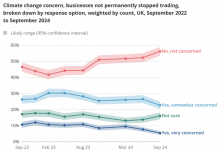Leading international property company Colliers has set out its predictions for 2024, following a difficult year for the market in 2023.
Key predictions:
- Total transactional volumes should reach a modest £50bn, reflecting a weak first half
- First interest rate cut expected by mid-2024 with Bank Rate at between 4.00 and 4.25 per cent by end-2024
- Modest recovery in H2 2024 (per annum growth for 2024 to reach 0.5 per cent)
- Yield expansion will stabilise by mid-2024 with signs of recompression later in H2
- Prime rents will continue to show positive growth across all sectors reflecting shortages of prime space
- Sub-prime rents will show increasing weakness especially for assets that are not ESG compliant and/or not easy to adapt to new working format.
Despite the year being expected to get off to a slow start, H1 will offer opportunistic investors the chance to snap up assets with limited competition notes the firm. Those investors who have readily available cash will be positioned to move at a faster rate than those dependent on debt, in a continuation of a trend from 2023.
Walter Boettcher, head of Research & Economics at Colliers, comments: “The UK commercial property market will enter an opportunistic phase in H1 2024 as increasing numbers of landlords facing refinance and higher debt costs begin to bring greater volumes of product to the market.
“A further short but sharp increase in yields is also expected in H1 2024, driven in large part by growing ESG concerns. Along with a lower interest rate trajectory this will also contribute to a material increase in transactional activity in H2 2024. As it stands, we expect next year to record transaction volumes of £50 billion, still below par but up on the circa £40 billion recorded in 2023.”
In the second half of the year a widely anticipated sense of market stability will materialise as the Bank of England lowers interest rates, with Colliers predicting the Bank Rate to reach between 4.00 – 4.25 per cent by the end of 2024. This will have a direct impact on the reduction of debt costs for many investors and will see a return of more lenders and competitive offers in the market. As inflation falls close to target, the cost-of-living squeeze on households and discretionary spending will begin to ease.
Laurence Richardson, director in the Debt Advisory team at Colliers, adds: “A growing consensus and the latest swap curves suggest that rates have peaked and may begin to fall in mid- to late 2024. Should cuts come sooner, they may be linked to a darkening economic outlook, so be careful what you wish for!
“Next year, LTVs for senior lending are expected to remain capped generally at 55%. Banks will continue to jostle with resourcing challenges presented by tricky legacy ‘backbook’ transactions while simultaneously wishing to originate new, high-quality transactions in a thin acquisition market. Alternative lenders will still secure attractive risk-adjusted deals due to more flexible risk analysis and underwriting processes than traditional lenders.”
The firm has pulled out ‘ones to watch’ for 2024:
- Further price adjustment is likely in the operational real estate sector before investors look build renewed momentum. This reticence is due in part to comparatively low historic yields in the sectors.
- Emerging sectors such as co-living will see increased activity as investors seek to find ‘alpha’ in the living market.
- In 2024, a resurging appetite to nail down the “S” in ESG will arise. A concerted effort will become visible to use experts and improve social measurement methods to lift the social veil and implement clear plans in this space.
- Following marginal growth in 2023, a challenging economic outlook will continue to impact with construction output expected to flatline in 2024. A ‘wait-and-see’ approach by many developers and occupiers will slow new development.
- Industrial will prove to be a safe bet for investment, despite supply increasing over the first three to six months of next year. A lack of new speculative development will create a supply pinch point for prime warehouses between Q4 2024 and Q1 2025 that may also lead to another surge in rents. Investors will continue to focus on value-add opportunities where they can drive performance though lease events in the short term to boost returns.
Walter Boettcher continues: “Next year looks more positive than 2023 but as we’ve learned in the last five years there are plenty of ‘unknown unknowns’ that could thwart this optimism. Reflecting on 2023 as a year of disrupted recovery after the pandemic hiatus, we should look into 2024 as a year of great promise.”




















